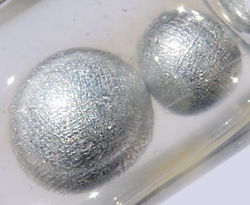Potassium
Potassium is a silvery-white metallic element that oxidizes rapidly in the air and whose compounds are used as fertilizer and in special hard glasses. It has the symbol K and atomic number 19. It is very reactive with water.
The English name for the element potassium comes from the word "potash", referring to the method by which potash was obtained – leaching the ash of burnt wood or tree leaves and evaporating the solution in a pot. Potash is primarily a mixture of potassium salts.
Potassium as nutrient for plants
Potassium ions are an essential component of plant nutrition and are found in most soil types. They are used as a fertilizer in agriculture in the form of chloride (KCl), sulfate (K2SO4), or nitrate (KNO3). About 90% of this potassium is supplied as KCl.
Plants need potassium for water management and transport of sugars in the plant. Especially crops like potatoes, cabbage and beets, which form sturdy stems and tubers, need potassium. Also fruit-bearing plants often require more potash.
Wood ashes, or ashes of other organic materials that contain some fiber, are a good organic source for potash fertilizer. Wood ashes contain about 6 per cent potash, plus considerable lime. Wood ashes are particularly good to use for adding potash to a compost heap.[1]
Symptoms of potassium deficiency in plants
Potassium deficiency is most common on light, sandy soils, because potassium ions (K+) are highly soluble and will easily leach from soils without colloids. Potassium deficiency is also common in chalky or peaty soils with a low clay content. It is also found on heavy clays with a poor structure.
Potassium deficiency is indicated by a burning of older leaves as well as chlorosis(yellowing) between leaf veins. This can slow down the growth of a plant because all of its older leaves drop prematurely. Purple spots may also appear on the leaf undersides. Plant growth, root development, and seed and fruit development are usually reduced. Deficient plants may be more prone to frost damage and disease, and their symptoms can often be confused with wind scorch or drought.
The deficiency is most common in several important fruit and vegetable crops; notably potatoes, Brassicas, tomatoes, apples, currants, gooseberries, and raspberries. Sugar beets, cereals, and clover are commonly affected by potassium deficiency as well.
- For a more detailed description of potassium deficiency see Potassium deficiency (plants) - Wikipedia
Potassium as nutrient in food
Potassium ions are necessary for the function of all living cells. It helps nerves and muscles communicate. It also helps move nutrients into cells and waste products out of cells. Potassium depletion in animals, including humans, results in various cardiac dysfunctions. Potassium is found in especially high concentrations within plant cells, and in a mixed diet, it is mostly concentrated in fruits such as grapes and blackberries, oranges and grapefruit, but also in leafy greens, root vegetables such as carrots and potatoes.
A diet rich in potassium helps to offset some of sodium's harmful effects on blood pressure.
- Read more about the medical effects of potassium on this page of University of Maryland Medical Center.

